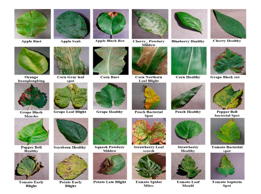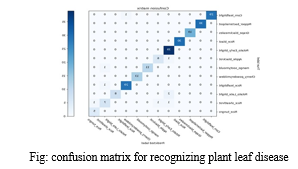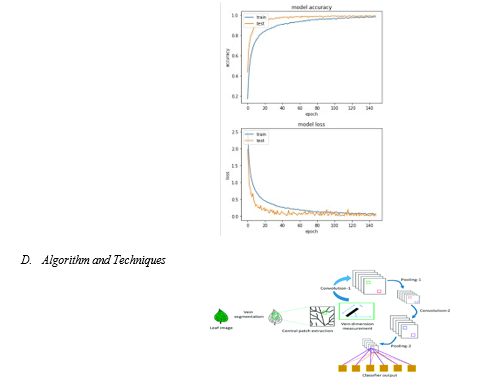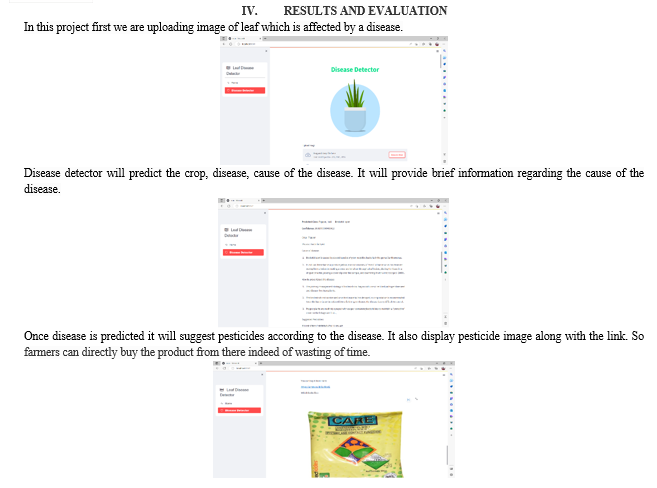Ijraset Journal For Research in Applied Science and Engineering Technology
- Home / Ijraset
- On This Page
- Abstract
- Introduction
- Conclusion
- References
- Copyright
Agronomy Leaf Disease Perception
Authors: Mrs. MD Jareena Begum, M. Nandini, K. Ragha Sudha, SK. Haseena, K. Amrutha, Y. Sujaika
DOI Link: https://doi.org/10.22214/ijraset.2023.50998
Certificate: View Certificate
Abstract
The perception and management of leaf diseases in agronomy is an important aspect of crop production. Leaf diseases can significantly reduce crop yield and quality, leading to economic losses for farmers. This paper explores the various factors that contribute to the perception of leaf diseases, crop, disease, cause of the disease and the use of agricultural practices such as pesticides and fertilization. Additionally, the paper examines various methods for disease management. By understanding the factors that contribute to leaf disease perception and implementing effective management strategies, farmers can mitigate the impact of these diseases on crop production and achieve better yields and profits. Aim of the project is to identify disease for multiple leafs.It can give description about the crop, disease, cause of the disease, recommend the pestcides and also provide amazon link for farmers easy to buy.
Introduction
I. INTRODUCTION
Agriculture is the mother of all civilizations. The focus is on improvement. Foliar diseases are very important as they can affect both the quality and quantity of crops in the context of agricultural development. Identifying leaf diseases is key to avoiding yield and crop losses. Leaf disease studies are studies of visually observable leaf patterns. Health monitoring and disease detection in leaves are essential for sustainable agriculture. Manual monitoring of leaf diseases is very difficult. It requires a tremendous amount of work, knowledge of leaf diseases, and excessive processing time. Plant diseases include fungi, bacteria, viruses, etc. Farmers usually see plants with the naked eye to detect and diagnose diseases. However, this approach can be time-consuming, expensive, and wrong.
The automatic recognition using image processing and deep learning methods works quickly and accurately. Photographic images of plant infection symptoms are used for plant disease detection and research, teaching and analysis, etc. Using computer image processing and deep learning technology to detect and classify plant leaf diseases and disease types. We can examine the image of the diseased leaf and get the characteristics of the infection site from the quantitative representation points for color , texture and other characteristics.
Research shows that image recognition techniques and deep learning work are effective methods to identify and classify plant diseases. Advances in the development of 2 technologies and experts in this field in recent years make it possible to obtain the optimal method for this. A lot of research is done every year in the emerging fields of image processing. Automatic detection of plant diseases is an important research topic because it can benefit from monitoring large agricultural fields and then automatically detect disease symptoms as they appear on plant leaves. So he's looking for a fast, automatic, inexpensive, and accurate way to detect disease by calculating leaf area using pixel count statistics. In this work, we propose a system that detects and classifies leaf diseases, leaf species, and recommends pesticides needed to treat leaf diseases using deep learning methods. We will use Deep Learning or the Convolutional Neural Network (CNN) method. Due to their worldwide fame, we will limit our work to different plant species.
A. Motivation
The motivation for studying agronomy and leaf disease perception is multifaceted .Firstly it is important to understand the causes of leaf this is in order to develop the effective strategy for their prevention and control. secondly by understanding the impact of leaf disease and on crop yield and quality agronomist can help the farmers to optimise the crop management practices this includes the selecting diseases resistant to cultivars ,implementing appropriate crop rotation and fertilisers prides and using effective pest management strategies. Finally the study of leaf this is in agronomy is important for food security by developing effective strategies for preventing and controlling leaf diseases agronomists can help you ensure that crops are healthy and abundant which is essential to feeding to growing global population. Identification of plant disease is the key to preventing the losses in the yield and quality of the agricultural product.
B. Objective
The goal of plant disease detection using leaf images is to design an incremental model for plant disease detection that ignores external features such as environment, noise, and background noise. This relates to the detection of various plant diseases and facilitates farmers' work or informs farmers of the detected disease. The classification approach using a convolutional neural network, which features excellent operational efficiency, provides accurate results. The system helps improve the performance. It is easy and manageable to maintain the project. Enhance a given input image through image acquisition and pre-processing. Identify the prospect through story analysis and segmentation. Classify the proportion of healthy and affected leaf according to the extraction and classification of the traits. Train your model on test data to get accurate results.
C. Existing System
Manually detecting leaf diseases by naked-eye observation is very difficult for all types of diseases and may not be very effective.
The existing system is compatible with Support Vector Machine (SVM) algorithm and Gaussian Mixture model to segment the image and detect leaf diseases. This model only works to detect multiple cut leaf diseases. A leaf image is provided as input and combined with pre-trained data to identify disease type. Foliar diseases are a constant threat from bacteria that cause huge crop losses worldwide .Machine learning, the latest breakthrough in computer vision, promotes detailed disease classification because the method uses an SVM classifier and a Gaussian mixture model for image segmentation. Disease detection and classification are considered to be the two most difficult tasks on the path to disease diagnosis. In the existing system it is possible to find only one door for each door. In it we only find the tomato leaf disease. The disadvantages of the existing system are that it is too difficult to train labelled records in a support vector machine. It is time consuming and expensive and also the accuracy is very low.
D. Proposed System
Detection of plant leaf diseases through feature extraction methods considering features such as shape, color and texture. Convolutional neural network (CNN), a deep learning The main goal of the proposed system is the technique, is used to classify plant leaves as healthy or diseased, and if it is a diseased plant leaf, CNN provides the name of that particular disease. Cures for certain diseases are suggested to help grow healthy crops and improve productivity. First, images of different leaves are taken with a high-resolution camera for better results and efficiency. Image processing techniques are then applied to these images to extract useful features needed for further analysis. We also try to classify diseases for a large number of different plant leaf types belonging to different regions. The big advantage is that diseases can be found on many leaves. CNN is very accurate in recognizing and classifying images, automatically detecting key features without human oversight.
In proposed system we can find the disease for multiple leafs .we can give the description about the crop,disease,cause of the disease,prevention of the disease recommend the pestcides and also provide the amazon link for easy to buy.
II. LITERATURE SURVEY
A. Visual Tea Leaf Disease Recognition using a CNN
It is proposed by the J.Chen in 2019.In this paper, the we can find the disease for the tea leaf only .the data include 8 categories of the tea leaf disease as well as category for healthy tea leaves. The author used data augmentation techniques to increase the size of the training datasets and reduce overfitting. The author achieved on overall accuracy of 95,55% on their test data sets, demonstrating the effectiveness of their approach. the importance for distinguishing between healthy and diseased tea leaves, while the later layers were more important for distinguishing between different types of tea leaf disease. The potential of CNN for visual tea leaf disease recognition, and highlights the importance of transfer learning and data augmentation techniques for achieving high accuracy in this task.
B. Image Processing Based Leaf Rot Disease Detection Of Betel Vine
It is proposed by the A. Dey in 2020.Betel vine leaf life time only 2-3 years with in 2-3 years crop yield production we can get due to the pathogen bacteria we can caused the disease. The proper drawback is the time consuming.in these case seeking the expert advice is very expensive and time consuming,hence,electronic expert systems are needed electronic experts system enable farmers in identifying type of diseases making the right decision and selecting the proper treatment. The expert systems are intelligent computer programs that are capable of offering of human experts in a solutions (or) advices related to specific problems in given domain.
C. A Leaf Disease Classification Model In Betel Vine Using Machine Learning Techniques
It is proposed by the md Zahid Hasan in 2021. Betel vine disease caused by regular endangerment to bacteria which causes a huge yield loss globally. Mostly the stem of the betel vine is kept in the soil so it is very usual that bacteria may attack the stem. Because of this bad quality leaf, farmers did not get the usual market price. There are lots of disease which can affect the normal amplification of betel vine, in conclusion, the production of betel vine has been compromised.
It is very important to develop a robotic system that can detect the leaf, stem diseases of betel vine at an early stage. These types of diseases can be detected automatically using machine learning techniques .Image processing methods have been performed feature extraction and image classification performed using SVM classifier. Almost 1275 images have been used in the dataset for training and testing purposes and the paper achieved 83.69% accuracy. The comparative analysis of our paper with other related works have been employed. The author will concentrate on finding faster computational machine learning model for learning with a better accuracy level and huge dataset as their future work.
III. SYSTEM MODEL
A. Data Exploration
As part of data mining, we take datasets from KAGGLE. Kaggle allows users to find and publish datasets, explore and build models in an online data science environment, collaborate with other data scientists and machine learning engineers, and enter competitions to solve data science problems. We retrieve 1120 photos from the KAGGLE data set. It belongs to three different classes: normal, benign and malignant.
B. Modules
There are four modules in this project they are Training the data sets, Image classification using CNN algorithm and Identifying the image belongs to which class.
- Training the Data Sets: We will use KAGGLE data sets to form the data For training the Data Sets we are going to use the KAGGLE Data Sets. We are using it because every day a new dataset is uploaded on Kaggle. Each dataset is a small community where one can discuss data, find relevant public code or create your projects in Kernels. Sometimes, you can also find notebooks with algorithms that solve the prediction problem in a specific dataset and the data science frameworks used for Kaggle competitions are surprisingly effective for similar real life problems.
- Data Collection: Data Collection is the first module in this project. We gather the data from the different websites. Collect a large dataset of images of healthy and diseased plant leaves. The dataset should be diverse in terms of plant species, types of diseases, and image Quality

3. Pre-processing: pre-processing refers to transformations applied to our data before it is fed into the algorithm. Data pre-processing is a technique used to transform raw data into a clean dataset. In other words, whenever data is collected from various sources, it is collected in a raw format that does not lend itself to analysis. Data pre-processing is a common first step in a deep learning workflow to prepare the raw data in a network-ready format. For example, you can scale the input image to match the input image's layer size. You can also pre-process the data to improve desired functionality or reduce artifacts that can overload the network.
4. Feature Extraction: The different features that are extracted are the length and width of the leaf, the area of the leaf, the perimeter of the leaf, the hull perimeter, district map along particular and horizontal axis in colour histogram and centre based development distance map.

In this feature extraction process where the disease will be found the leaf parts like midrib,vein,blade,small netted vein, margin.
5. Image Classification: Image classification is the process of categorizing an image into one of several predefined classes or categories based on the features present in the image. We can classify the image if the leaf is the healthy or unhealthy. If the leaf is the unhealthy we can recommend the pesticides based on the diseases.
C. Research methodology
Let us assume I is the intensity values and Px:Py and Pxy considered as derivatives which have 4 corners (0,0) ,(0,1),(1,0) and (1,1) of unit square .the interpolated intensity surface is 0and aij are coefficient.the final confusion matrix has 2x2 dimensions and the average values of the n confusion matrices for all classes. Accuracy, sensitivity, specific, precision false positive, false negative, true positive and true negative had been performed using a confusion matrix.
Sensitivity: Sensitivity is a measure of the ability of a diagnostic test to correctly identify individuals who have a disease. In the context of leaf disease perception, it measures the proportion of infected plants that are correctly identified as positive by a diagnostic tool or method.
Sensitivity = (True positives) / (True positives + False negatives)
Specificity: Specificity is a measure of the ability of a diagnostic test to correctly identify individuals who do not have a disease. In the context of leaf disease perception, it measures the proportion of healthy plants that are correctly identified as negative by a diagnostic tool or method.
Specificity = (True negatives) / (True negatives + False positives)
Positive predictive value (PPV): PPV is a measure of the probability that a positive test result actually indicates the presence of the disease. In the context of leaf disease perception, it measures the proportion of plants identified as positive that are actually infected.
PPV = (True positives) / (True positives + False positives)
Negative predictive value (NPV): NPV is a measure of the probability that a negative test result actually indicates the absence of the disease. In the context of leaf disease perception, it measures the proportion of plants identified as negative that are actually healthy.
NPV = (True negatives) / (True negatives + False negatives)
Perception index (PI): The PI is a measure of how well an observer can perceive a disease in a population of plants. It takes into account both sensitivity and specificity, as well as the prevalence of the disease in the population.
PI = (Sensitivity + Specificity - 1) / Prevalence
Where prevalence is the proportion of plants in the population that are infected with the disease. A higher PI value indicates better perception accuracy.


We use CNN for image classification purposes. CNN is a kind of deep learning model for data processing with a grid pattern. A CNN is a mathematical construct typically made up of three types of layers (or building blocks): convolution, pool, and fully connected layers. The first two layers, convolution and fusion, perform feature extraction while the fully combined third layer maps the extracted features into a final output such as classification. When a level passes its output to the next level. In this project, the CNN algorithm is used to classify the image.
E. Model Evaluation and Validation
Plant leaf disease detection is an important application of computer vision in agriculture. In order to evaluate and validate a model for plant leaf disease detection, the following steps can be taken:
- Model Selection: Choose an appropriate model architecture for the task of plant leaf disease detection. Popular models for image classification tasks include Convolutional Neural Networks (CNNs) such as VGG, Reset, and Inception.
- Model Training: Train the selected model on the training set. The model should be trained using an appropriate loss function such as categorical cross-entropy and optimized using a suitable optimization algorithm such as Stochastic Gradient Descent (SGD).
- Model Evaluation: Evaluate the performance of the trained model on the validation set. Common metrics used for evaluation include accuracy, precision, recall, F1-score, and confusion matrix.
- Hyper parameter Tuning: Fine-tune the hyper parameters of the model to improve its performance on the validation set. Hyper parameters that can be tuned include learning rate, batch size, number of epochs, and regularization parameters.
- Model Testing: Evaluate the final performance of the model on the testing set. This provides an unbiased estimate of the model's performance on new and unseen data.
- Interpretation: Interpret the results of the model by visualizing the learned features and identifying the most important features for distinguishing between healthy and diseased plant leaves.
By following these steps, it is possible to evaluate and validate a model for plant leaf disease detection and to identify areas for the further improvement.

V. FUTURE WORK
Developing more effective and sustainable disease management strategies: While there are several methods for managing leaf diseases, many of these methods can have negative impacts on the environment or human health. Investigating the impact of climate change on disease perception and management: Researchers should investigate how changing environmental conditions will affect disease perception and management, and develop new strategies to mitigate these impacts. Developing new diagnostic tools for disease detection: Rapid and accurate disease diagnosis is critical for effective disease management. Researchers should work to develop new diagnostic tools and technologies that can quickly and accurately detect plant diseases in the field.
Conclusion
The perception and management of leaf diseases in agronomy play a critical role in crop production. Effective disease management strategies can help farmers reduce the impact of leaf diseases on crop yield and quality, thereby maximizing profits. It is important to understand the factors that contribute to disease perception, including environmental conditions, plant genetics, and agricultural practices, in order to develop effective disease management strategies. The author of the paper mainly focused on CNN-based deep learning techniques for agronomy leaf disease perception and classification .image processing method have been performed future extraction and image classification performed using CNN classifier.almost 55103 images have been used in the data set for training and testing purposes and the paper achieved 98% accuracy. The use of resistant cultivars, cultural practices, and chemical control can all be effective methods for managing leaf diseases. By implementing these strategies, farmers can minimize the impact of leaf diseases on their crops and ensure the continued success of their agricultural operations.
References
[1] P. Narvekar, and S. N. Patil, “Novel algorithm for grape leaf diseases detection” International Journal of Engineering Research and General Science Volume 3, Issue 1, pp.no 1240-1244, 2015 [2] S., V.D.; Singla, A.; Ghanshyam, C.; Kapur, P.; Gupta, S. Plant leaf imaging technique for agronomy. In Proceedings of the 2011 International Conference on Image Information Processing, Shimla, India, 3–5 November 2011; pp. 1–5. [3] R. Kaur and M. Kaur” An Adaptive Model to Classify Plant Diseases Detection using KNN”International Journal of Trend in Scientific Research and Development (IJTSRD) ISSN: 2456-6470. [4] V. M. J [1], Thamizharasi. A [2] “A Survey on Plant Disease Identification” International Journal of Computer Science Trends and Technology (IJCST) – Volume 3 Issue 6, Nov-Dec 2015 [5] K. P. Ferentinos, “Deep learning models for plant disease detection and diagnosis,” Computers and Electronics in Agriculture, no. September 2017, pp. 311–318. [6] J. Hossain, M.A. Amin, Leaf shape identification based plant biometrics. In Proceedings of the 2010 13th International Conference on Computer and Information Technology (ICCIT), Dhaka, Bangladesh, 23–25 December 2010; pp. 458–463 [7] P. J.K.1 and R. Kumar2 \"FEATURE EXTRACTION OF DISEASED LEAF IMAGES” Journal of Signal and Image Processing ISSN: 0976-8882 & E-ISSN: 0976-8890, Volume 3, Issue 1, 2012, pp.-60-63. [8] R. C., et al., “Detection and Recognition of Leaf Disease using Image Processing,” International Journal of Engineering Studies and Computing, vol/issue: 7(5), pp. 11964- 11967, 2017. [9] Sharada P Mohanty, David P Hughes, and Marcel Salath´e.“Using deep learning for image-based plant disease detection”.In: Frontiers in plant science 7 (2016), p. 1419. [10] T. Rumpf, A.-K.Mahlein, U. Steiner, E.-C. Oerke, H.-W. Dehne, and L. Pl\'umer, “Early detection and classification of plant diseases with support vector machines based on hyperspectral reflectance,” Computers and Electronics in Agriculture, vol. 74, no. 1, pp. 91- 99, 2010. [11] J. Chen, Q. Liu and L. Gao, \"Visual Tea Leaf Disease Recognition Using a Convolutional Neural Network Model\", Symmetry, vol. 11, no. 3, p. 343, 2019. Available: 10.3390/sym11030343. [12] A. Dey, M. Sharma and M. Meshram, \"Image Processing Based Leaf Rot Disease, Detection of Betel Vine (Piper BetleL.)\", Elsevier, pp. 748-754, 2020.
Copyright
Copyright © 2023 Mrs. MD Jareena Begum, M. Nandini, K. Ragha Sudha, SK. Haseena, K. Amrutha, Y. Sujaika. This is an open access article distributed under the Creative Commons Attribution License, which permits unrestricted use, distribution, and reproduction in any medium, provided the original work is properly cited.

Download Paper
Paper Id : IJRASET50998
Publish Date : 2023-04-25
ISSN : 2321-9653
Publisher Name : IJRASET
DOI Link : Click Here
 Submit Paper Online
Submit Paper Online

